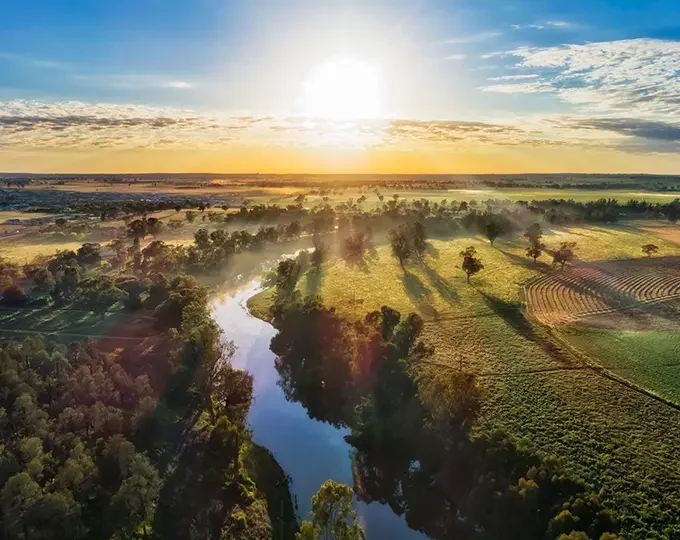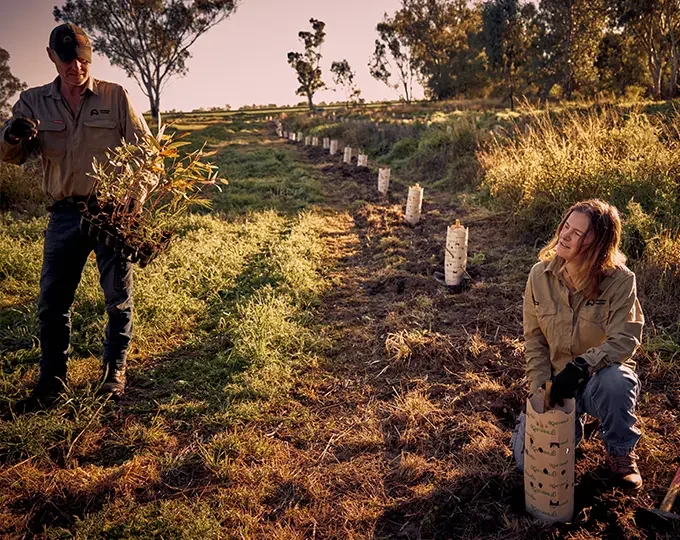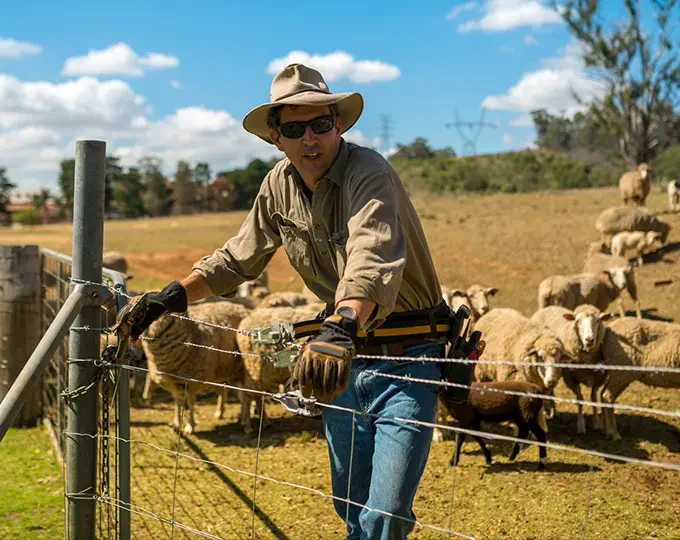
Introduction
The Landcare CarbonSMART Environmental Plantings Toolkit for landholders is designed for eligible Australian farmers and landholders interested in finding out more about carbon farming through environmental plantings projects.
The primary goal of the toolkit is to provide eligible farmers and landholders with easy to understand, practical guidance on participating in the nature-positive carbon market through planning, establishing, and managing environmental plantings projects.
What is in the toolkit?
The Toolkit is broken into six modules, allowing you to find the information you need, including:
- An overview of environmental markets, outlining benefits and risks
- A summary of the Reforestation by Environmental or Mallee Plantings method 2024 methodology
- Detailed information on the process to plan and implement activities under the method
- Information on understanding your farm’s carbon footprint and some of the tools available to help you navigate environmental markets
- An outline of the key stages in a typical project lifecycle
- General information on financial considerations, including funding options and ownership structures
The development of this Toolkit was supported by funding through the Country Road Climate Fund.
Disclaimer
This general information has been prepared by Landcare Australia (AR 1315198 of Australian Carbon Traders Pty Ltd AFSL 425512) for farmers and landholders who are eligible to be treated as wholesale clients. It does not take into account your objectives, needs or situation. ACCUs and derivatives are financial products. While we have outlined common benefits, risks and constraints here, we strongly recommend you seek independent financial and legal advice before acting on any decision to invest. Click here for further regulatory information.
Further reading...
References
- Carbon farming. NSW Climate and Energy Action https://www.energy.nsw.gov.au/business-and-industry/programs-grants-and-schemes/primary-industries-carbon-farming (2023).
- Newness, regulatory additionality and government program requirements | Clean Energy Regulator. https://cer.gov.au/schemes/australian-carbon-credit-unit-scheme/how-to-participate/apply-to-participate/newness-regulatory-additionality-and-government-program-requirements.
- Methods for the Nature Repair Market – DCCEEW. https://www.dcceew.gov.au/environment/environmental-markets/nature-repair-market/methods-for-the-nature-repair-market.
- Department of Energy, E. and C. A. Trees for farm health – Agriculture. Agriculture Victoria https://agriculture.vic.gov.au/climate-and-weather/understanding-carbon-and-emissions/trees-for-farm-health (2024).
- ACCU Market Monthly Report – September 2024 | Insights | CORE Markets. https://coremarkets.co/insights/accu-market-monthly-report-september-2024.
- Department of Primary Industries and Regional Development. Planning a Reforestation Project. (2024).
- Draft Reforestation by Environmental or Mallee Plantings method 2024 – Climate. https://consult.dcceew.gov.au/draft-accu-environmental-plantings-method-2024.
- Choose a project proponent | Clean Energy Regulator. https://cer.gov.au/schemes/australian-carbon-credit-unit-scheme/how-to-participate/plan-your-project/choose-project-proponent.
- ASIC. AFS licensing and the Carbon Farming Initiative: A fact sheet for advisers and project developers. https://asic.gov.au/regulatory-resources/financial-services/carbon-markets/afs-licensing-and-the-carbon-farming-initiative-a-fact-sheet-for-advisers-and-project-developers/.
- ASIC. AFS licensing and the Carbon Farming Initiative: A fact sheet for farmers and land managers. https://asic.gov.au/regulatory-resources/financial-services/carbon-markets/afs-licensing-and-the-carbon-farming-initiative-a-fact-sheet-for-farmers-and-land-managers/.
- Code of Conduct. Carbon Market Institute https://carbonmarketinstitute.org/code/.
- Department of Energy, E. and C. A. Selling carbon from trees and soils – Agriculture. Agriculture Victoria https://agriculture.vic.gov.au/climate-and-weather/understanding-carbon-and-emissions/selling-carbon-from-trees-and-soils (2021).
- Carbon Opportunity Decision Support Tool (CODST). http://carbontool.farminstitute.org.au/.
- ANU Sustainable FarmsDigital. Protect and restore paddock trees. https://www.sustainablefarms.org.au/on-the-farm/paddock-trees/.
- Trees on Farms: Connecting landowners with investors to grow timber, carbon or biodiversity | A platform for landowners in Victoria to identify the potential biodiversity, carbon and timber benefits from growing trees on their land, and to connect with organisations with funds to invest in these trees. https://growcarbon.science.unimelb.edu.au/.
- Nuberg, I. K. Effect of shelter on temperate crops: a review to define research for Australian conditions. Agrofor. Syst. 41, 3–34 (1998).
- Trees for Shelter – a guide to using windbreaks on Australian farms (chapter 1). AgriFutures Australia https://agrifutures.com.au/product/trees-for-shelter-a-guide-to-using-windbreaks-on-australian-farms/.
- 3. Establishing an ACCU Scheme project – DCCEEW. https://www.dcceew.gov.au/climate-change/emissions-reduction/agricultural-land-sectors/carbon-farming-outreach-program/training-package/topic-5/3-establishing-accu-scheme-project#dcceew-main.
- Example Contract Clauses. Carbon Market Institute https://carbonmarketinstitute.org/example-contract-clauses/.
- On-farm greenhouse gas accounting tools | Understanding carbon and emissions | Climate and weather | Agriculture Victoria. https://agriculture.vic.gov.au/climate-and-weather/understanding-carbon-and-emissions/onfarm-greenhouse-gas-accounting-tools.
- Department of Energy, E. and C. A. Making cent$ of carbon and emissions on-farm – Agriculture. Agriculture Victoria https://agriculture.vic.gov.au/climate-and-weather/understanding-carbon-and-emissions/making-cents-of-carbon-and-emissions-on-farm (2020).
- Ruminati | Agricultural Emissions Tracking. Ruminati https://ruminati.com.au/undefined.
- Ruminati | Ruminati PRIME. Ruminati https://ruminati.com.au/undefined.
- Natural Capital Accounting Benchmarking Project. Landcare Australia https://landcareaustralia.org.au/naturalcapital/.
- Method catalogue. Accounting for Nature https://www.accountingfornature.org/method-catalogue.
- Full Carbon Accounting Model (FullCAM) – DCCEEW. https://www.dcceew.gov.au/climate-change/publications/full-carbon-accounting-model-fullcam.
- Carbon Sequestration. https://looc-c.farm/introduction.
- CER. Participating in the Emissions Reduction Fund. A guide to the reforestation by environmental or Mallee plantings FullCAM method.
- Forward abatement estimates | Clean Energy Regulator. https://cer.gov.au/schemes/australian-carbon-credit-unit-scheme/how-to-participate/apply-to-participate/forward-abatement-estimates.
- Eligible interest-holder consent | Clean Energy Regulator. https://cer.gov.au/schemes/australian-carbon-credit-unit-scheme/how-to-participate/apply-to-participate/eligible-interest-holder-consent.
- Permanence obligations | Clean Energy Regulator. https://cer.gov.au/schemes/australian-carbon-credit-unit-scheme/how-to-participate/permanence-obligations.
- Many markets in one: Valuing risk, opportunity and co-benefits in the ACCU market | Insights | CORE Markets. https://coremarkets.co/insights/valuing-cobenefits-in-the-accu-market.
- Chrissy Elmer. Accounting for Nature and Landcare Farming Native Vegetation Methof. (2022).
- Kilter Rural & Natural Decisions. A Native Woodland Bird Assessment Methodology for diverse regenerating farmlands. (2024).
Resources
| Resource | Type of information | Link |
|---|---|---|
| Landcare Australia CarbonSMART | Information on the Landcare Australia CarbonSMART program. | https://landcareaustralia.org.au/landcare-carbonsmart/ |
| ACCU Scheme Planning a project webpage | It provides links to information that should be considered when planning an ACCU Scheme carbon project | https://cer.gov.au/schemes/australian-carbon-credit-unit-scheme/how-participate/plan-your-project |
| Establishing an ACCU Scheme Project | Main requirements in establishing an ACCU Scheme project including deciding on a project proponent | https://www.dcceew.gov.au/climate-change/emissions-reduction/agricultural-land-sectors/carbon-farming-outreach-program/training-package/topic-5/3-establishing-accu-scheme-project |
| ACCU Scheme participation overview | Provides an overview of the process of engaging with the ACCU scheme and the steps involved | https://cer.gov.au/schemes/australian-carbon-credit-unit-scheme/how-participate |
| Opportunities for the soil and vegetation sequestration decision tree | Diagram to assist in deciding on the appropriate method for soil and vegetation sequestration | https://cer.gov.au/document/soil-and-vegetation-sequestration-decision-tree |
| Requirements for all planting project | Flow diagram of all requirements | https://cer.gov.au/document/requirements-all-planting-projects |
| Permanence obligations | Information about the obligations of a project | https://cer.gov.au/schemes/australian-carbon-credit-unit-scheme/how-participate/permanence-obligations |
| PLANR | PLANR is the Platform for Land and Nature Repair database, which is provided by the department and supports participation in the Nature Repair Market Scheme. | https://planr.gov.au/ |
| Contract obligations | Information about important considerations in entering a carbon abatement contract | https://cer.gov.au/schemes/australian-carbon-credit-unit-scheme/how-participate/project-reporting-and-audits |
| Legislation and regulation | Links to Australian carbon market legislation | https://www.legislation.gov.au/C2011A00101/latest/versions https://www.legislation.gov.au/F2015L00156/latest/versions |
| Reforestation by environmental or mallee plantings FullCAM method | Method and associated guidance (DRAFT) | https://consult.dcceew.gov.au/draft-accu-environmental-plantings-method-2024 |
| Reducing the risk of fire | Guidance on reducing fire risk and preserving sequestered carbon in vegetation project | https://cer.gov.au/document/reducing-risk-fire-and-preserving-sequestered-carbon-accu-vegetation-projects |
| Eligibility | eligibility requirements for projects | https://cer.gov.au/schemes/australian-carbon-credit-unit-scheme/eligibility-accu-scheme |
| Newness and regulatory additionality | Newness and regulatory additionality requirements for projects | https://cer.gov.au/schemes/australian-carbon-credit-unit-scheme/how-to-participate/apply-to-participate/newness-regulatory-additionality-and-government-program-requirements |
| Legal right | Demonstrating legal right for projects | https://cer.gov.au/schemes/australian-carbon-credit-unit-scheme/how-to-participate/plan-your-project/legal-right-and-native-title |
| Nature repair market | Information on emerging Nature Repair Market | https://www.dcceew.gov.au/environment/environmental-markets/nature-repair-market |
| Carbon Market Institute | Independent institute with the aim of capacity building to accelerate the transition to net zero. Also provide the and manage the Industry Code of Conduct | https://carbonmarketinstitute.org/ |
| NSW Government Carbon Farming | Overview of benefits and opportunities for carbon farming in NSW. | https://www.energy.nsw.gov.au/business-and-industry/programs-grants-and-schemes/primary-industries-carbon-farming |
| Victorian Carbon Farming Program | Victorian Carbon Farming Program (VCFP) provides an opportunity for private landholders to reduce emissions and build resilience to a changing climate | https://agriculture.vic.gov.au/climate-and-weather/policy-programs-action/victorian-carbon-farming-program |
| Department Climate Change, Energy, Environment and Water – Carbon farming outreach program | Training packages and grants to support Australian farmers and land managers to reduce emissions and store carbon. | https://www.dcceew.gov.au/climate-change/emissions-reduction/agricultural-land-sectors/carbon-farming-outreach-program/training-package |
| AgriFutures’ A farmer’s handbook to on-farm carbon management | Information about ways to manage your carbon farming project, including working with developers | A farmer’s handbook to on-farm carbon management |
| On farm carbon calculators | list of tools available to assist farm businesses in estimating on-farm greenhouse gas emissions and carbon sequestration | https://agriculture.vic.gov.au/climate-and-weather/understanding-carbon-and-emissions/onfarm-greenhouse-gas-accounting-tools |
Glossary of terms
| Term | Meaning |
|---|---|
| ACCU | A tradeable financial product issued to individuals or businesses who run eligible projects that reduce or avoid emissions. Each unit represents one tonne of carbon dioxide equivalent that would have otherwise been released into the atmosphere |
| ACCU Project | Eligible offsets projects registered under the ACCU Scheme. |
| ACCU Scheme | An Australian Government scheme that offers landholders, communities and businesses the opportunity to run projects in Australia that avoid the release of greenhouse gas emissions or remove and sequester carbon from the atmosphere. It is enacted through the Carbon Credits (Carbon Farming Initiative) Act 2011 and the Carbon Credits (Carbon Farming Initiative) Rule 2015 |
| AFSL | AFSL Australian Financial Services Licence. Regulated carbon products such as ACCUs and derivatives are financial products under the Corporations Act 2001 (Cth). Providers of financial services are required to hold an AFSL or be an authorised representative of a licensee. |
| Carbon Estimation Area | Individual footprint area within the larger project area upon which a carbon project is modelled and credits are issued. The project area and carbon estimation area can be the same, however several carbon estimation areas can also exist within a single project area |
| Carbon farming | The process of changing agricultural practices or land use to increase the amount of carbon stored in the soil and vegetation (sequestration) and to reduce greenhouse gas emissions from livestock, soil or vegetation (avoidance). |
| Carbon Offset | A type of carbon credit that represents a reduction in emissions – whether prevented from entering the atmosphere or removed from the atmosphere – that is used to compensate for emissions that occur elsewhere. |
| Carbon sequestration | The removal of carbon dioxide from the atmosphere by capturing and storing it in vegetation and soil. |
| Carbon stock | The carbon that remains in stored trees while they grow |
| Clean Energy Regulator (CER) | A Commonwealth statutory authority that administers regulatory schemes relating to clean energy, including the Renewable Energy Target, the Carbon Pricing Mechanism (now repealed), the National Greenhouse and Energy Reporting scheme, and the ACCU Scheme. |
| Co-benefit | Additional benefits provided by a registered carbon project. For Environmental Plantings-based carbon projects co-benefits may include community engagement, First Nations opportunities, productivity, improved soil health, climate resilience, enhanced biodiversity, and improved water management |
| Crediting period | In relation to a carbon crediting project, for example an ACCU project, the crediting period is the length of time the project is eligible to be issued carbon credits. |
| Indigenous estate | Land that has been purchased, vested, reserved for or leased on behalf of an Aboriginal land trust. Generally freehold but may be leased or reserved on behalf of an Aboriginal land trust. Ownership rights and privileges under Indigenous freehold vary with jurisdiction legislation. |
| Insetting | Refers to undertaking emissions reduction projects or activities within an entity’s own value chain or operations. |
| Land use change | Refers to a change in the use or management of land by humans, which may lead to a change in land cover. |
| Permanence period | A length of time that a sequestration project must maintain carbon stores. |
| Project area | Area identified at registration and designated through the project approval process upon which carbon project activity can occur. ACCUs are based on the size of the individual carbon estimation areas located within a project area. |
| Project developer | Organisation or individual responsible planning, implementing and managing the project. This may include managing funding, on-ground works, on sale of credits and project proponent activities |
| Project methodology | Methodology produced by the Clean Energy Regulator, or another relevant authority for non-ACCU projects, that outlines the guidelines for how the project should be implemented and managed |
| Project Proponent | Person or organisation legally responsible for the administration, implementation and management of the project. In the case of a project registered in Australia, all ACCUs will be issued to the proponent |
| Reversal event | When carbon that was removed from the atmosphere is subsequently released back into the atmosphere, whether by natural disturbance or some other cause. |
| Scope 1 Emissions | The release of greenhouse gases into the atmosphere as a direct result of activities occurring within a responsible entity’s control (or geographic boundary). |
| Scope 2 Emissions | The release of greenhouse gases into the atmosphere from the consumption of electricity, heating, cooling or steam that is generated outside of a responsible entity’s control (or geographic boundary). |
| Scope 3 Emissions | Greenhouse gases emitted as a consequence of a responsible entity’s activities (other than Scope 2 emissions) but beyond the responsible entity’s control or geographic boundary. |





